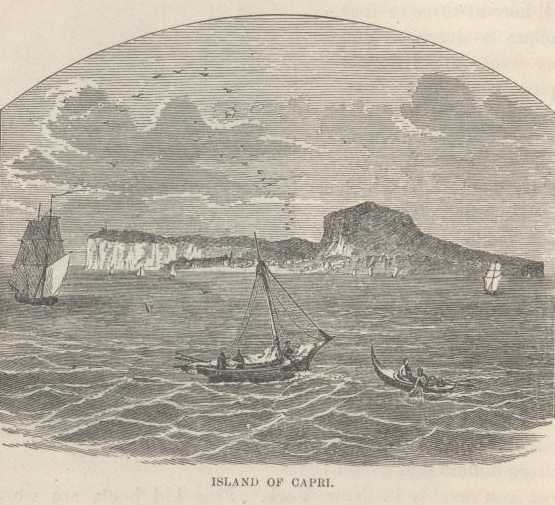And thus the wonderful Blue Grotto is suggested to me. It is situated on the Island of Capri, twenty-two miles from Naples. We chartered a little steamer and went out there. Of course, the police boarded us and put us through a health examination, and inquired into our politics, before they would let us land. The airs these little insect Governments put on are in the last degree ridiculous. They even put a policeman on board of our boat to keep an eye on us as long as we were in the Capri dominions. They thought we wanted to steal the grotto, I suppose. It was worth stealing. The entrance to the cave is four feet high and four feet wide, and is in the face of a lofty perpendicular cliff--the sea-wall. You enter in small boats--and a tight squeeze it is, too. You can not go in at all when the tide is up. Once within, you find yourself in an arched cavern about one hundred and sixty feet long, one hundred and twenty wide, and about seventy high. How deep it is no man knows. It goes down to the bottom of the ocean. The waters of this placid subterranean lake are the brightest, loveliest blue that can be imagined. They are as transparent as plate glass, and their coloring would shame the richest sky that ever bent over Italy. No tint could be more ravishing, no lustre more superb. Throw a stone into the water, and the myriad of tiny bubbles that are created flash out a brilliant glare like blue theatrical fires. Dip an oar, and its blade turns to splendid frosted silver, tinted with blue. Let a man jump in, and instantly he is cased in an armor more gorgeous than ever kingly Crusader wore.

Then we went to Ischia, but I had already been to that island and tired myself to death “resting” a couple of days and studying human villainy, with the landlord of the Grande Sentinelle for a model. So we went to Procida, and from thence to Pozzuoli, where St. Paul landed after he sailed from Samos. I landed at precisely the same spot where St. Paul landed, and so did Dan and the others. It was a remarkable coincidence. St. Paul preached to these people seven days before he started to Rome. Nero’s Baths, the ruins of Baiae, the Temple of Serapis; Cumae, where the Cumaen Sybil interpreted the oracles, the Lake Agnano, with its ancient submerged city still visible far down in its depths--these and a hundred other points of interest we examined with critical imbecility, but the Grotto of the Dog claimed our chief attention, because we had heard and read so much about it. Every body has written about the Grotto del Cane and its poisonous vapors, from Pliny down to Smith, and every tourist has held a dog over its floor by the legs to test the capabilities of the place. The dog dies in a minute and a half--a chicken instantly. As a general thing, strangers who crawl in there to sleep do not get up until they are called. And then they don’t either. The stranger that ventures to sleep there takes a permanent contract. I longed to see this grotto. I resolved to take a dog and hold him myself; suffocate him a little, and time him; suffocate him some more and then finish him. We reached the grotto at about three in the afternoon, and proceeded at once to make the experiments. But now, an important difficulty presented itself. We had no dog.